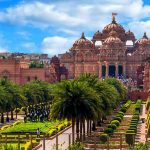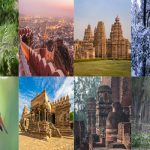India, a land of vibrant traditions and diverse cultures, is a canvas of celebrations, where every festival becomes a spectacle of colors, lights, and joy. In this journey through the heart of India’s events and celebrations, we explore the tapestry of festivals that paint the nation with cultural richness and celebration highlights that capture the essence of each revelry.
Festivals: A Cultural Extravaganza
1. Diwali – The Festival of Lights:
Diwali, the festival of lights, illuminates India with a spectacular display of lamps, candles, and fireworks. Homes adorned with colorful rangoli, the sweet aroma of traditional sweets, and the joyous atmosphere make Diwali a celebration that transcends borders.
2. Holi – The Festival of Colors:
Holi, a riot of colors, is a joyous occasion where people come together to celebrate the victory of good over evil. Brightly colored powders, water balloons, and laughter fill the air, creating a vibrant kaleidoscope of hues.
3. Eid-al-Fitr – The Festival of Breaking the Fast:
Eid-al-Fitr is a joyous celebration marking the end of Ramadan. Families come together for special prayers, feasts, and the exchange of gifts, spreading love and harmony.
4. Navratri and Durga Puja – Worship and Dance:
Navratri, a festival dedicated to the goddess Durga, sees nine nights of vibrant dance performances, colorful attire, and elaborate decorations. Durga Puja, particularly celebrated in West Bengal, is a grand affair with artistic pandals and processions.
5. Ganesh Chaturthi – Welcoming the Elephant God:
Ganesh Chaturthi is a ten-day celebration honoring Lord Ganesha. Elaborate processions, traditional music, and the immersion of intricately crafted idols in water signify the farewell to the beloved elephant-headed deity.
Celebration Highlights: Moments of Grandeur
1. Kumbh Mela – The World’s Largest Spiritual Gathering:
The Kumbh Mela, held every 12 years, is a spiritual gathering where millions of pilgrims come to bathe in the sacred rivers. The energy, devotion, and sheer scale of this event make it a highlight in India’s cultural calendar.
2. Republic Day Parade – A Spectacle of Patriotism:
India’s Republic Day Parade in New Delhi is a grand showcase of military prowess, cultural diversity, and patriotic fervor. The parade, featuring colorful floats, traditional dances, and military contingents, marks the adoption of the Indian Constitution.
3. Pushkar Camel Fair – Where Tradition Meets Trade:
The Pushkar Camel Fair is a unique blend of cultural festivities and a vibrant livestock fair. Camels adorned with colorful accessories, traditional music, and competitions create a lively atmosphere in the desert town of Pushkar.
4. Rann Utsav – Celebrating White Deserts and Culture:
The Rann Utsav in Gujarat is a celebration of the unique landscape of the White Rann and the rich cultural heritage of the region. Traditional music, dance, and the breathtaking view of the white desert under the full moon make it a mesmerizing experience.
5. Onam – Harvest Festival of Kerala:
Onam, the harvest festival of Kerala, is marked by the famous snake boat races, traditional dances, and a grand feast called Onasadya. The vibrant floral carpet, known as Pookalam, adds to the festive charm.
As we navigate through the events and celebrations of India, it becomes clear that each festival and celebration highlight is not just a moment in time; it’s a reflection of the country’s rich history, cultural diversity, and the spirit of unity in celebration.

FAQs: Navigating the Tapestry of India’s Events and Celebrations
Q1: What makes Diwali the Festival of Lights in India?
- A: Diwali, the Festival of Lights, symbolizes the victory of light over darkness and good over evil. The lighting of lamps, candles, and fireworks represents the triumph of positivity and enlightenment.
Q2: How is Holi celebrated in different regions of India?
- A: Holi is celebrated with variations in traditions across India. While the throwing of colored powders and water balloons is common, some regions have unique customs like the Lathmar Holi in Mathura.
Q3: What is the significance of Eid-al-Fitr in India?
- A: Eid-al-Fitr marks the end of Ramadan, the holy month of fasting. The festival is celebrated with special prayers, feasts, and the exchange of gifts, fostering a sense of communal harmony and joy.
Q4: Why is the Kumbh Mela considered a spiritual pilgrimage?
- A: The Kumbh Mela is a massive gathering where pilgrims come to bathe in sacred rivers, believing it cleanses them of sins. It is considered a spiritual journey that occurs every 12 years, rotating between four locations in India.
Q5: How does the Republic Day Parade showcase India’s diversity?
- A: The Republic Day Parade in New Delhi showcases India’s diversity through cultural displays, traditional dances, and state-wise tableaux. It reflects the unity in diversity that is a defining characteristic of the nation.
Q6: What makes the Pushkar Camel Fair a unique cultural event?
- A: The Pushkar Camel Fair is a unique blend of cultural festivities and a livestock fair. It features camel races, traditional music, and vibrant markets, making it a celebration that highlights both cultural and trade aspects.
Q7: What is the significance of the Rann Utsav in Gujarat?
- A: The Rann Utsav celebrates the unique landscape of the White Rann and the cultural heritage of Gujarat. It includes traditional music, dance performances, and cultural activities against the backdrop of the mesmerizing white desert.
Q8: How do snake boat races contribute to the festive spirit of Onam?
- A: Snake boat races are a traditional highlight of Onam, the harvest festival of Kerala. Teams row long, narrow boats to the rhythm of traditional songs, creating a vibrant and competitive atmosphere.
Q9: Why is the Republic Day Parade in New Delhi held on January 26th?
- A: January 26th marks the day when the Indian Constitution came into effect in 1950, replacing the Government of India Act (1935). The Republic Day Parade is held to honor this historic moment.
Q10: How can visitors participate in or witness these events and celebrations in India?
- A: Visitors can plan their trips to coincide with specific festivals or events, check local event calendars, and engage with the local community. Many tourism boards provide information on cultural festivals and celebrations.
Explore the richness of India’s events and celebrations through these FAQs, and discover the cultural vibrancy that defines this diverse and enchanting nation.







